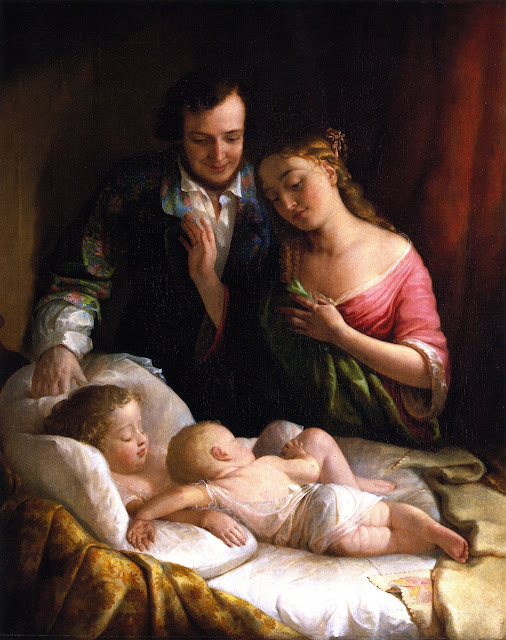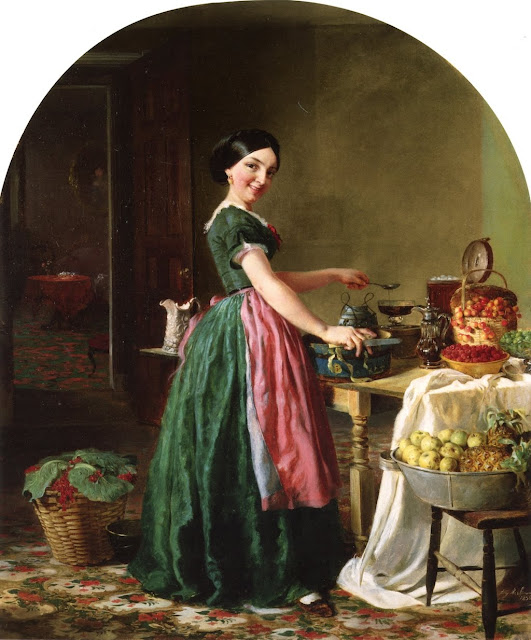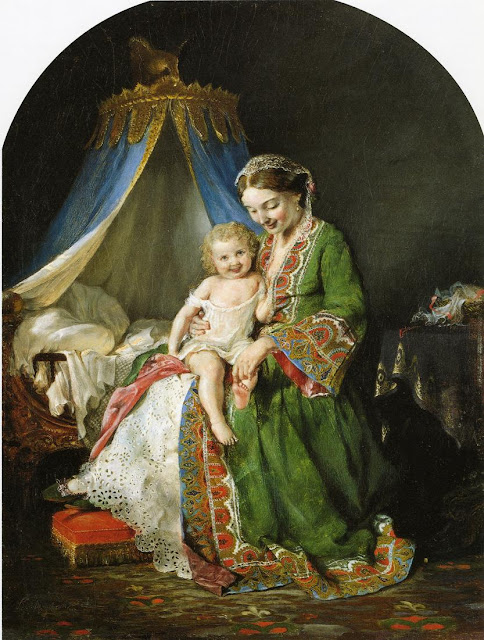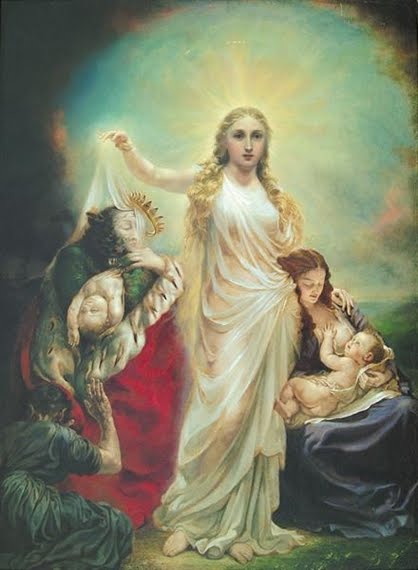 |
| Self-portrait, 1841, age 19 |
The first successful woman artist in America was Lilly Martin Spencer. In the 1850s, when Rosa Bonheur was a prominent animal-painter in France, Lilly became one of the most popular and widely reproduced genre painters in the U.S. She achieved particular success with humorous domestic subjects.
Although Lilly's paintings featured figures and told stories, her greatest strength lay in her ability to depict objects with meticulous detail and invisible technique, in the manner of the Dutch genre painters of the 1600s. No matter what the theme, every painting includes extraordinary still life elements.
As a woman, she is an early example of "having it all"—namely, combining the roles of artist and mother. While becoming one of the most popular artists in the country, she gave birth to 13 children, six of whom survived, and filled the unusual role of breadwinner for her large family.
Lilly Martin was born in England to liberal French educators, who emigrated to the United States with their 3 children in 1830, when Lilly was 8. They lived in New York for three years before moving to rural Ohio, to help establish a commune that followed the theories of a Progressive French philosopher. They devoted themselves to an agrarian life, sharing and rotating labor; they supported both abolition and women's suffrage.
Lilly and her 2 brothers were home-schooled by their highly educated parents using books from their vast library. She had some art training while the family was in New York City. After they moved to Ohio, Spencer was encouraged by two local artists, who introduced her to oils.
At 17, she filled the plaster walls of the family farmhouse with charcoal murals that included full-sized portraits of family members, a water view as seen from a public square, and domestic scenes of a boy teasing a cat, a woman kneading bread, and a child taking its first step. Spencer became a local celebrity and her home a local tourist attraction.
By the time she was 18 Spencer had produced over 50 oil paintings, including portraits, genre scenes, and scenes inspired by literature. In order to raise money for her studies, she held her first exhibition in 1841, when she was 19. It attracted a great deal of attention from critics.
That same year, Lilly moved to Cincinnati, home to an active artists' colony. Several months later, her father Giles moved to Cincinnati and taught private French lessons to help support her.
At the age of 22, three years into her career, Lilly married the English tailor Benjamin Rush Spencer.
Benjamin soon realized that Lilly would be the main provider for the family, so he took on all the domestic chores commonly assigned to the wife and helped with the business side of Lilly's work.
A critical factor in Lilly's career is the fact that she gave birth to 13 children, 6 of whom died young. On top of all the time and energy occupied by pregnancy and child raising, Lilly had the stress of sickly children in the house, and the paralyzing sadness of losing a child to get through, over and over. Moreover, supporting the family was her responsibility, so a lot was riding on every painting. Economic necessity forced Lilly to paint for the market place. However, none of this stress was reflected in Lilly's paintings, which idealized domestic happiness.
By the time she was 24, 1846, Lilly had firmly established herself in Cincinnati as a leading local artist, producing genre scenes in addition to the usual portraits. Over the next few years, several of her works were engraved for distribution, which added to her finances and her reputation.
In 1848, the Spencers moved to New York City. There she began a period of intense work, producing paintings by day while attending courses at night. The public clamored for genre works more than for other styles, especially the sentimental and humorous anecdotal scenes Spencer produced, and she became extremely popular. By 1852, her work brought higher prices than that of George Caleb Bingham or William S. Mount, who are now much more famous genre painters. She produced her most popular works between 1848 and 1858.
She received commissions to paint portraits of several important people, including the wife of President Benjamin Harrison, and feminist Elizabeth Cady Stanton.
Lilly also received commissions to illustrate books and magazines, including Godey's Lady's Book, which had nationwide distribution. Although she was extremely talented and versatile, critical appreciation for Lilly's work has been limited by the fact that in a large number of her works, the figures have over-sized heads, with comically broad expressions. Since she was quite capable of getting the proportions correct, it seems likely that these works were commissioned to illustrate a particular theme, such as "the joys of housework," or some theme appropriate to a lady's magazine. [Some of her more well-known paintings are Domestic Happiness (1849), The Jolly Washerwoman (1851), Peeling Onions (1852), Shake Hands (1854), "This Little Pig Went to Market" (1857), and The Gossips (1857)].
In 1858, when she was 36, the Spencers were offered a house and studio in Newark New Jersey by a wealthy industrialist who wanted her to paint portraits of his children. There they could grow their own food, as Lilly's parents had done in Ohio.
During the 1860s, the market for sentimentality and obvious humor declined. Lilly moderated her style and broadened her subject matter. Her work got better, but she never regained her popularity. She made a bid to join the ranks of the masters with a large allegory called Truth Unveiling Falsehood. She also painted scenes of home life during the Civil War that had a greater sense of unease and tension than any of her early works.
In the 1870s her paintings were exhibited at the National Academy of Design, and she was represented at the Women's Pavilion of the Philadelphia Centennial of 1876.
In 1880 the family moved to rural New York.
Benjamin died in 1890, after 46 years of marriage.
Lilly continued working until her death at age 79.
Thanks both to her gender and to her topical subject matter, Spencer was largely forgotten until 1978, when the Smithsonian American Art Museum gave her a retrospective exhibition. Since then there has been a revival of interest in her work, however most articles about her on the internet tend to be dismissive.
Our photos of Lilly's work:
 |
| The Jolly Washerwoman, 1851 Dartmouth Photo by Dan L. Smith |
 |
| Conversation Piece, 1852 Metropolitan / Jan's photo, 2012 |
 |
| The Young Wife: First Stew, 1854 North Carolina / Jan's photo, 2010 |
 |
| Young Husband: First Marketing, 1854 Metropolitan Photo by Dan L. Smith |
 |
| We Both Must Fade (Mrs. Fithian), 1869 (age 47) Smithsonian / Jan's photo, 2010 |
Internet examples
This was Lilly's first big hit:
 |
| Domestic Happiness, 1849, age 27 55" x 45" (4 1/2 feet tall) Detroit / Internet |
 |
| Peeling Onions, c. 1852 |
The painting below is now considered politically obnoxious, but the child's expression is charming without being demeaning. There was a fad for paintings of poor children doing cute things.
 |
| Height of Fashion, 1854 Lithograph of lost painting |
 |
| Kiss Me and You'll Kiss the 'Lasses, 1856 Brooklyn / Internet |
 |
| This Little Piggy Went to Market, 1857 (age 35) 16" x 12" New Britain / Internet |
 |
| Still Life with Watermelon, Pears, and Grapes, ca. 1860 (age 38) NMWA / Internet |
In the painting below, the central figure is the artist's rotund husband, wearing a white suit, who has just landed on the ground after the rope on a tree swing gave way. The artist is the serious woman, wearing a lavender dress, on the left, with outstretched arms.
 |
| The Artist and Her Family at a Fourth of July Picnic, c. 1864, age 42 NMWA / Internet |
 |
| The War Spirit at Home: Celebrating the Battle at Vicksburg, 1866 Newark / Internet |
 |
| Truth Unveiling Falsehood, 1869 |
*Several Peale daughters were among the first acknowledged women painters in America.
Angelica Kauffmann Peale (1775-1853), daughter of Charles Willson Peale (and named after his favorite female painter) had been instructed in drawing by her father and enjoyed a close relationship with him.
Sarah Mirriam Peale (1800-1885), daughter of James Peale, was the most celebrated of the Peale women, painting portraits and still lifes through the first decades of the 19th century. In 1818, Sarah and her sister Anna Claypoole Peale (1791-1878), a gifted miniature painter, were elected to membership in the Pennsylvania Academy of the Fine Arts, the first women artists to be so honored.
Their sister Margaretta Angelica Peale (1795-1882) also excelled at still-life painting.
Rosalba Carriera Peale (1799-1874), daughter of Rembrandt, was a portraitist, landscape painter, and lithographer.
Mary Jane Peale (1827-1902), the only daughter of Rubens Peale, was an art teacher, having acquired her own training from her uncle Rembrandt and the Philadelphia portraitist Thomas Sully.
The careers of these women were aided by an expanding class of art patrons in the early years of the 19th century and by increased opportunities for exhibitions in galleries and art academies.